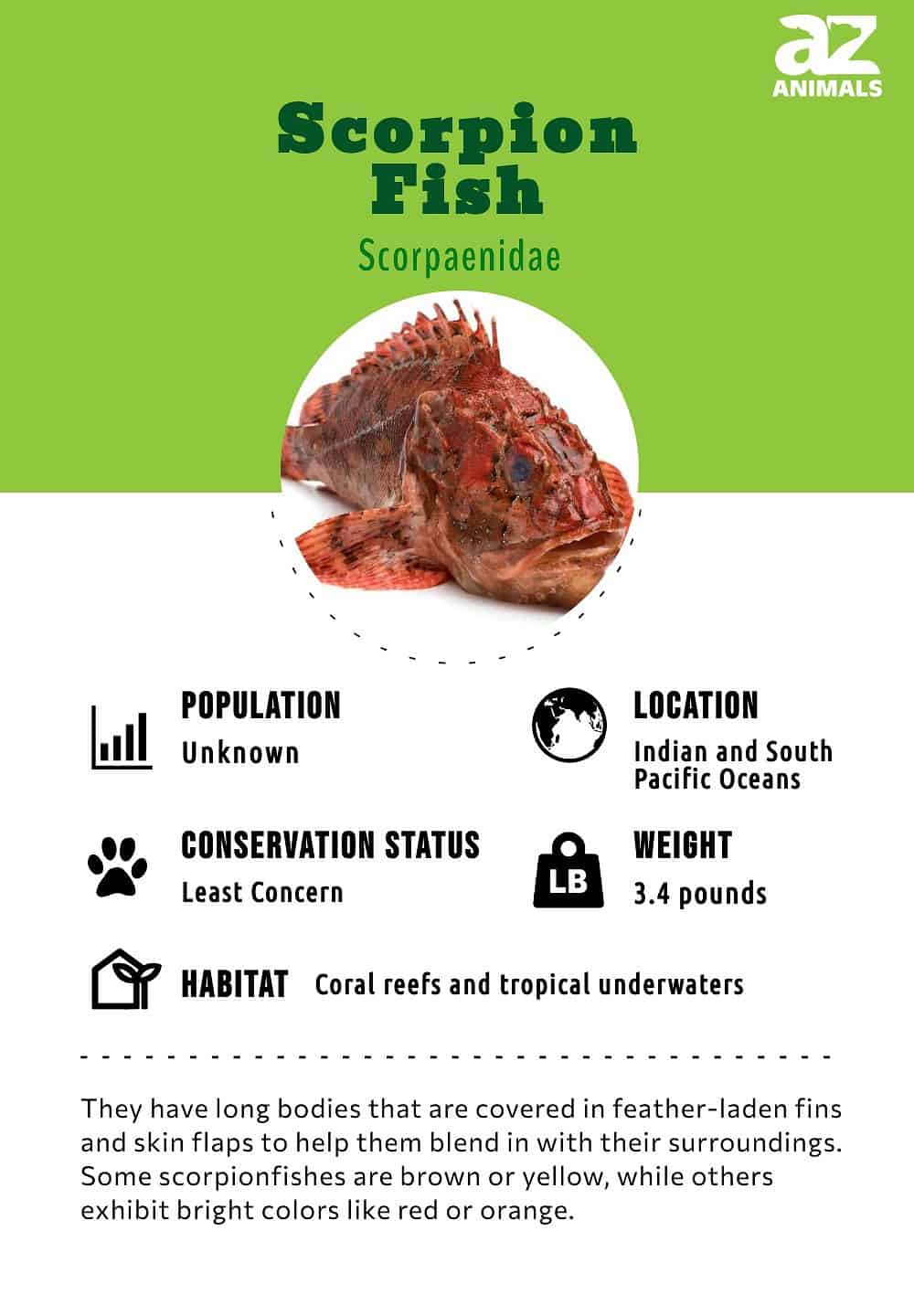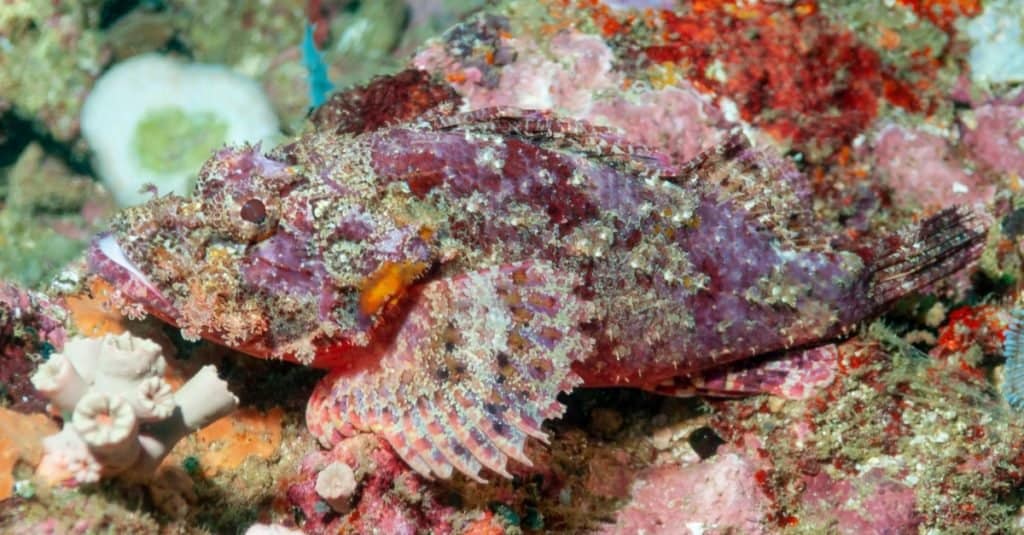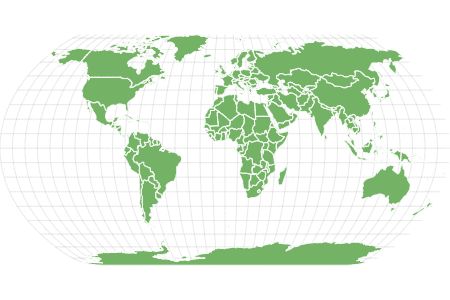Scorpion Fish
Scorpaenidae
These fishes have venom covered spines all over their bodies.
Advertisement
Scorpion Fish Scientific Classification
- Kingdom
- Animalia
- Phylum
- Chordata
- Class
- Actinopterygii
- Order
- Scorpaeniformes
- Family
- Scorpaenidae
- Scientific Name
- Scorpaenidae
Read our Complete Guide to Classification of Animals.
Scorpion Fish Conservation Status
Scorpion Fish Facts
- Prey
- Coral reef, snails, and small fishes
- Group Behavior
- Solitary
- Fun Fact
- These fishes have venom covered spines all over their bodies.
- Estimated Population Size
- Not known
- Biggest Threat
- Sharks, rays, and large snappers
- Most Distinctive Feature
- Venom mucous covered sharp spines
- Gestation Period
- 3 to 18 months
- Optimum pH Level
- 8.1 - 8.4
- Habitat
- Indian Ocean, Pacific Ocean, and Indonesia
- Predators
- Sharks, snappers, and rays
- Diet
- Omnivore
- Favorite Food
- Coral reefs, small fishes, snails
- Type
- Fish
- Common Name
- Scorpionfish
- Number Of Species
- 198
- Average Clutch Size
- 6000
- Slogan
- There are more than 200 recognised species!
View all of the Scorpion Fish images!
Scorpion Fish has sharp spines that are covered in poisonous mucus that allow them to attack if necessary.
The scorpionfish, also known as Scorpaenidae, is a large family of fishes and usually includes hundreds of members. Most fishes from this family are venomous and can sting predators to defend themselves.
The sting from this fish can cause intense pain and can also cause swelling. It is said that the venom from the sting can spread to other parts of the body quickly, requiring fast medical attention.
These fishes usually exist at a depth of around 800 meters in the littoral zone and are often known to be motionless around rocks and algae.
Incredible Scorpion Fish Facts!
- These fishes are known to be some of the most poisonous sea creatures because of their sharp venomous spines.
- These fishes usually live at the surface of the water but can also be found as deep as 800 meters into the sea.
- They do not like existing in groups and come together only for reproduction purposes.
- Because of their appearance, it is easy for these fishes to camouflage with their surroundings.
- Despite being dangerous, these fishes are really small in size.

Classification And Scientific Name
The Scorpion fishes go by the scientific name Scorpaenidae and belong to the kingdom Animalia and Phylum Chordata. They come from the class and order Actinopterygii and Scorpaeniformes respectively. There are about 100 to 200 subspecies and types of Scorpionfish.
The scientific name Scorpaenidae comes from New Latin, combining Scorpaena and the suffix -idae. Scorpaena can be traced back to the Ancient Greek σκόρπαινα, which comes from the Greek word for scorpion. Interestingly, the Greek word for Scorpion is rooted in the Proto-Indo-European verb (s)ker, which means “to cut.”
Evolution And Origin
The scorpionfish, which is also called a rockfish, belongs to a family of fish that is believed to have evolved during the mid-Miocene period, around 15.97 million to 11.6 million years ago. Based on fossil information discovered, it is believed that this species began to diversify in the late Miocene.
Types Of Species

This marine family is made up of over 200 members.
©Jesus Cobaleda/Shutterstock.com
Scorpionfishes make up one of the largest marine families and consist of 100 to 200 different fish family members. Some of the more popular species include lionfish, firefish, turkey fish, stingfish, and stonefish. The stonefish is the deadliest species of Scorpaenidae. Each of these is then broken down into multiple types within their own families.
Presently, there are a total of 10 subfamilies, though 338 species fall into these categories, according to reports in 2018. However, the total amount will vary, based on where you get your information.
Scorpionfish vs. Stonefish
Scorpionfishes have longer bodies while stone fishes have more of a round body shape. Meanwhile, the scorpionfishes have eyes that protrude, and the stone fishes have eyes that dig deeper down into their skulls. Another difference between the scorpionfish and the stonefish is that the former has a forward sitting jaw while the latter has a more upturned, grumpier-looking one.
Appearance

Scorpionfish camouflage themselves with the seafloor and wait to ambush passing prey
©Porco_Rosso/Shutterstock.com
Scorpionfishes have long bodies that are covered in feather-laden fins. They have skin flaps that also help them easily camouflage and blend in with their surroundings.
Some scorpionfishes are brown or yellow, while others exhibit bright colors like red or orange. They are known to become almost invisible when they are near reefs and rocks.
The size of the scorpionfish is about 8 inches to 12 inches, and it weighs around 3.4 pounds.
They are usually motionless while near algae or rocks and also have venomous spines that are sharp and covered in poisonous mucous.
Distribution, Population, And Habitat

Scorpionfish are usually found where there is plenty of coral and the water is temperate.
©Bildagentur Zoonar GmbH/Shutterstock.com
The scorpionfishes are usually found in the Indo-Pacific regions and also inhibit the tropical underwater of the Indian ocean. Apart from that, these fishes are also found in the central and western parts of the Pacific Ocean and also in several parts of Indonesia.
These fishes usually exist where there are plenty of coral reefs and the temperature of the water is temperate. This is because the right temperatures help them survive better and the coral reefs help these fishes hide from predators efficiently.
The population of the scorpionfish is not known. However, fishes belonging to these families do exist in large numbers as more than 200 fishes are part of this family. They are, however, ‘not extinct’ as listed by the NOAA.
Predators And Prey
Even though the scorpionfishes themselves are poisonous and dangerous, they still fall prey to some of the sea creatures including large snappers, rays, and sharks. With so few predators, the scorpionfish can thrive greatly when it releases thousands of eggs to be fertilized. Still, this fish is dominant in its own right, so the predators that come after it must be equally threatening.
Meanwhile, they also feed on certain creatures including small fishes and snails. They also feed on crustaceans and coral reefs. Humans can become a victim of their sting, which will require immediate medical attention. While waiting for emergency services, the wound needs to be cleaned with the hottest water that the skin can handle for at least 30 minutes.
Reproduction And Lifespan

Scorpion fish eggs are released in the water and stay afloat near the surface where they are later hatched.
©viper345/Shutterstock.com
These fishes are oviparous. The female scorpionfishes often produce transparent or greenish eggs.
The eggs, as well as the sperms from the female and male scorpionfishes respectively, are released in the water and stay afloat near the surface of the water, where they are later attached.
However, other than that, not much is known about the mating process of these fishes. The lifespan of these fishes is usually about 15 years.
In Fishing And Cooking
Even though these fishes are not commonly caught because of the venom they carry around, some people do fish them out and also cook them. Scorpionfishes are safe to consume and are also world-famous delicacies. Scorpionfish chips are very famous, and most people compare the flavor to a combination of sea bass and monkfish.
The easiest place to fish for them is in the South Pacific Ocean since they are commonly found in coral reefs. Still, fishers should be careful while fishing around these reefs so that they don’t destroy the local environment.
There is no shortage of recipes online for scorpionfish, depending on the species that is prepared. Due to their lack of meat, the cooking process doesn’t take long, and most dishes are ready within a matter of 10 minutes or less. When cooked properly, it doesn’t quite have the flakiness that some other fish do, but it is also incredibly tender.
Their thin meat absorbs other flavors well, much like any other crustacean. Anyone looking to prepare scorpionfish at home will want to stock up on some butter and spices, regardless of the recipe chosen.
To get the maximum flavor, try out the pan-roasted method seen here.
View all 293 animals that start with SScorpion Fish FAQs (Frequently Asked Questions)
What is a scorpionfish?
A scorpionfish is a long, venomous marine creature. This family includes a variety of fishes and has about 100 to 200 different fishes as family members. They have exceptional camouflage abilities and are known to be some of the most poisonous fishes in the world.
What do scorpionfish eat?
These fishes eat small fishes, snails, and coral reefs.
How poisonous is a scorpionfish?
Scorpionfishes are known to be some of the most poisonous fishes in the world and have sharp venom-covered spines on their bodies.
Is scorpionfish good to eat?
Yes, Scorpion fishes are used in dishes world-wide.
What happens if you touch a scorpionfish?
The scorpionfishes sting upon being touched. The affected area can be very painful and can swell up instantly. The venom can also spread to other parts of the body.
Where are scorpionfish found?
These fishes are found in parts of the Indian Ocean, the Pacific Ocean, and Indonesia. They usually exist in temperate waters and places where there are plenty of coral reefs.
What Kingdom do Scorpion Fish belong to?
Scorpion Fish belong to the Kingdom Animalia.
What class do Scorpion Fish belong to?
Scorpion Fish belong to the class Actinopterygii.
What phylum to Scorpion Fish belong to?
Scorpion Fish belong to the phylum Chordata.
What family do Scorpion Fish belong to?
Scorpion Fish belong to the family Scorpaenidae.
What order do Scorpion Fish belong to?
Scorpion Fish belong to the order Scorpaeniformes.
What type of covering do Scorpion Fish have?
Scorpion Fish are covered in Scales.
What are some predators of Scorpion Fish?
Predators of Scorpion Fish include sharks, snappers, and rays.
How many eggs do Scorpion Fish lay?
Scorpion Fish typically lay 6,000 eggs.
What is an interesting fact about Scorpion Fish?
There are more than 200 recognized species of Scorpion Fish!
What is the scientific name for the Scorpion Fish?
The scientific name for the Scorpion Fish is Scorpaenidae.
What is a distinguishing feature of the Scorpion Fish?
Scorpion Fish have venomous, mucous-covered, sharp spines.
How many species of Scorpion Fish are there?
There are 198 species of Scorpion Fish.
What is the biggest threat to the Scorpion Fish?
The biggest threats to the Scorpion Fish are sharks, rays, and large snappers.
What is the optimal pH for a Scorpion Fish?
The optimal pH for a Scorpion Fish is between 8.1 and 8.4.
How many Scorpion Fish are left in the world?
The population size of the Scorpion Fish is unknown.
How do Scorpion Fish have babies?
Scorpion Fish lay eggs.
What are the differences between scorpion fish and lionfish?
The main differences between a scorpionfish and a lionfish are that they belong to different evolutionary groups, utilize different hunting strategies, and inhabit different parts of the world.
Thank you for reading! Have some feedback for us? Contact the AZ Animals editorial team.
Sources
- David Burnie, Dorling Kindersley (2011) Animal, The Definitive Visual Guide To The World's Wildlife
- Tom Jackson, Lorenz Books (2007) The World Encyclopedia Of Animals
- David Burnie, Kingfisher (2011) The Kingfisher Animal Encyclopedia
- Richard Mackay, University of California Press (2009) The Atlas Of Endangered Species
- David Burnie, Dorling Kindersley (2008) Illustrated Encyclopedia Of Animals
- Dorling Kindersley (2006) Dorling Kindersley Encyclopedia Of Animals
- Wikipedia, Available here: https://en.wikipedia.org/wiki/Scorpaenidae
- Oceana, Available here: https://oceana.org/marine-life/ocean-fishes/scorpionfish
- Florida Museum, Available here: https://www.floridamuseum.ufl.edu/discover-fish/species-profiles/scorpaena-plumieri/

















